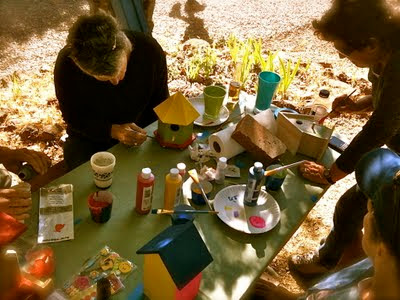David Michael Kennedy is a 60-year-old art photographer from New Mexico who took an extraordinary cross-country journey to rediscover what he thought was a lost America. He shares his photos here, and responds to a few questions.
In the '70s and '80s,
David Michael Kennedy lived in New York City, shooting portraits of music icons like Bob Dylan, Bruce Springsteen and Muddy Waters for magazine and album covers. He moved to New Mexico in 1986, where he focused on Native American culture. Today he lives in a 200-year-old adobe house in the tiny agricultural village of El Rito in northern New Mexico.
But for two years beginning in 2004, Kennedy wandered back roads photographing preachers, crawfishermen, RV-ers, buffaloes, longhorns, cowboys and mystics.
He and his then girlfriend, Heather Howard, and a res dog named Henry Crow Dog packed up in a 1959 Airstream trailer outfitted with a wet darkroom. He took all his photographs with a handmade 4x5 camera using Polaroid positive/negative film, which he developed in the trailer then made contact prints using the archaic platinum palladium process prized by collectors and museums.
John Burnett: Why did you take this trip across the country?
David Michael Kennedy: I got divorced, my house burned down and I didn't know what to do. It was March 2004 and I was confused about where America was going. I was watching the news and it didn't make sense. It seemed to me America was broken and the people were a mess. I decided to go out and rediscover America and myself.

Enlarge Courtesy of David Michael Kennedy "The Wigwam Village Motel in Holbrook, Ariz., is one of the last remaining wigwam motels in the country. At one time there were 15 of them stretched all across the U.S. on Route 66 — old concrete teepees. This was number six."
At the end of the trip, most of what I felt is there was still a spirit within the people. Once I got out there, I found people who were reinventing their lives, who were not going to strip malls, who were not feeding that consumer monster. The deeper we penetrated into the back roads of America — what I think of as the real America — the less I found of that.

"We camped in Ochlockonee River State Park in Florida and every day I'd walk by this tent and there was a Madonna, an old car and nobody around. It fascinated me. After a couple of days, Randy crawled out of the tent. He was on a pilgrimage to a statue that was bleeding in Mississippi. He ran out of money waiting for his miracle. I gave him $20 for gas and he went down the road to see the statue."
There were people who didn't need to text, there were people who didn't need iPods, there were people who actually had coffee pots you could take apart and fix when they broke. We met one old man and his wife; 50 years ago he made an electric tractor that was still running, and he heated his entire house with solar panels that he'd made from beer cans, which he'd drunk.
Did you know where you wanted to go when you set out, or was the trip completely unscripted? We had no plan for this trip. Every morning when we woke up I'd look up at the sky and think, "Heading north today." The trip began to get scripted by the people we met.
"Sister Reiddie was a Pentecostal minister who was just amazing. When I photographed her, she couldn't decide whether she should be holding a Bible or a shotgun."
- David Michael Kennedy
V.R. Hylton was a minister we met in Texas; we stayed with him for over a week and ended up going to his church and fishing in his lake and photographing his longhorns. V.R. told us about some old cowboy crop-dusters over in Louisiana. When we left V.R., we headed over to Louisiana to try to find the crop-dusters. Of course we made a wrong turn ... the trip was really about wrong turns.
We passed a roadside fruit stand and spent a week with the people who ran the fruit stand. They introduced us to crawfishermen and we had huge crawfish feasts. Then they introduced us to Sister Reiddie.
Tell me about the Airstream trailer.
We traveled for two years living in that vintage Airstream. It still has a 1959 lifetime warranty stuck to the closet door. We did a little modification to it so I could process film at night. Heather made blackout curtains, or we'd just park in dark places and I processed and printed in the trailer.

"We'd spent a week looking for a buffalo in Yellowstone when I came upon this one. I jumped out of the car and ran over. I set up the tripod. I got the cable release and he looked in the wide lens and froze. I did a one-second exposure, and once the shutter closed, he snorted and walked away. That was so much what the trip was about. So many subjects gave me such amazing gifts."
And I think the Airstream kind of helped. A big blue Dodge pickup with an Indian motorcycle in back, pulling this huge silver reflective trailer down the road. It definitely drew people to us. It made people interested in what we were doing.
What was it about these moments that made you go and get your camera?
They're just things that touched me. There are moments that grab me and make me say "yes."
This feels right and natural and good, and I make a picture.









